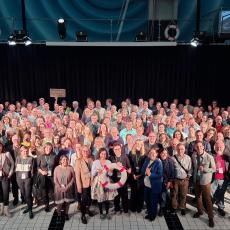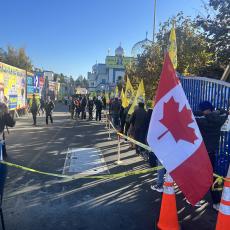Transforming City Charter Processes Through Democratic Innovation
This essay was originally published in the National Civic Review. Photo credit: Town Charter of Flensburg, 1284 via Wikimedia. CC BY-SA 3.0,
Introduction
In the next five years, at least a dozen cities in the United States will
review their city charters to determine if and how their local government
processes might change. In an era of increasing polarization and cynicism,
charter revision offers an opportunity to revitalize local democracy by
improving and altering government systems and increasing the public’s
role in decision making.
Participating in the review of a city charter is a unique opportunity. City
charters are like local constitutions. They establish the institutional
structures, the legal powers, and the duties and responsibilities of
local government. Constitutions do not change very often, and it is
even rarer for the public to have a significant role in determining what
they contain. By contrast, the charter review process – and the public
referendum that typically results – provide unique opportunities for
the public to inclusively learn, deliberate, and prescribe new ways of
doing local democracy.
This article addresses two common problems with charter review
processes.
First, these processes are vulnerable to undue political
influence – both in the selection of charter commissions and in the
setting of the commission’s agenda. Second, these processes are often
inaccessible to everyday residents and unrepresentative of a city’s
many diversities. And the traditional engagement methods used often
do not provide sufficient opportunities for public learning, listening,
discussion, connection, and collective impact. We propose addressing
these problems with representative deliberative processes, which put
people from all walks of life in place of a hand-selected commission.
In addition, the article proposes several ways to incorporate lottery-
selected deliberative processes into charter language, as ongoing
improvements in local democracy.
Civic Engagement and Charter Review Processes
There is a significant record of public engagement linked to the structural
reform of city governance. The original Model City Charter (1898)
created by the National Civic League was a guide for municipalities to
forge a local social contract between citizens and representatives, such
that the institutions and relationships that would be embodied in the
charter would reflect public preferences and political needs of the time.
The evolution and modernization of city governance has coincided with
the need to update government documents to address social pressures,
new legislative requirements, and new challenges. By the time of
the second model charter in 1915, citizen participation was aligned
with new and expansive voting procedures. Suffrage and the base of
popular voting of elected representatives was being broadened to new
sections of the population, and citizen decision-making was becoming
commonplace through initiatives, referenda, recall, and citizen advisory
committees.
The review and drafting of content in city charters continues to have
an element of public engagement depending on the municipality, but
this is not a formal requirement. The most recent Model City Charter
outlines the foundations for healthy civic infrastructure that will treat
public engagement as integral to governance.
Once a charter commission is established, it will work on potentially
altering a form of government (ex. strong mayor versus city manager) to
be better aligned with the preferences of citizens, or seek to redistribute
powers among elected officials, appointed officials and governing
bodies as well as between city officials and citizens. A commission
carries out research and analysis of the current charter and charters
of adjacent municipalities. Based on existing and previous example
charter review processes, there are three aspects of a charter review
process:
Charter revision has an initiation process:
• Legislation (state or municipality) requires the review of the
charter between a set period of time
• A legislative body can convene a charter review process
• Citizens can trigger a charter review process through an initiative
Charter revision has multiple possible forms:
• Citizens can form a charter review commission on their own
• A mayor or council can select the commissioners
• Some type of democracy innovation like a citizens’ assembly can
be used
Charter revision has a ratification process:
• The commission’s proposed changes go directly to referendum
(often requires supermajority support of the commission)
• The commission submits its proposed changes to a local
council; any supported changes, with modifications, then go to
referendum
• The commission submits its proposed changes to a local council;
any supported changes become part of a special act, which goes
to the state legislature, then to a referendum
Generally, a charter commission is authorized by law, often with
members appointed by the mayor or council members, or sometimes
via election. A chair is then selected to lead meetings and facilitate
the work of the commission. Some type of funding schedule might be
allocated. Then a commission will often carry out research, and a public
education and outreach campaign.
Public engagement generally takesthe form of public hearings involving expert testimony, followed by a
traditional town hall public comment period to the commission. Some
charter commissions might host place-based community meetings
to draw in community partners and hear from diverse voices. Most
commissions are 12 to 18 months long, but it is not uncommon for
them to last more than two years due to various internal challenges
like attrition. Following the drafting of a revised charter, there may be
further community feedback on the commission’s proposed changes.
Then, the proposed changes may go either 1) directly to the public via
referendum, 2) to city council (or a council committee) for approval or
modification, then to referendum, or 3) to council, then to the state
legislature, then to referendum.
Charter review processes often use traditional engagement practices
that members of the public tend to dislike, such as public hearings, and
sometimes there is no public engagement at all. Public engagement is very limited if the only opportunity to be heard is at a microphone
for a couple of minutes. Also, where there are limited opportunities
for meaningful deliberation, the people that tend to show up (in small
numbers) are often unrepresentative of the community.
As a result, the public might feel that there was insufficient participation
and awareness of the process, and this might lead to the draft not
being approved by voters. This means that it is important to hear from
parts of the community that are not often engaged or included in
official government consultative processes. At the same time, charter
commissions might appear as being too politically (or personally) aligned
with elected leaders because of how commissioners are selected, which
impacts the legitimacy of an authentic, independent process.
Better forms of community collaboration involve active listening to
nuanced perspectives. There should be multichannel in-person and
digital opportunities to learn, discuss and make decisions about charter
contents. Communities should utilize the strengths of small group
facilitated work, in conjunction with crowdsourced online ideas and
discussion.
Below, we argue that charter review commissions should begin to use
representative deliberative processes to guide the commission process,
and also as a regular facet of governance within a charter. These
processes are unique for three reasons.
First, participants from all walks of life are selected by democratic lottery. A letter is sent to thousands
of randomly selected residential addresses, then residents respond, and
respondents are selected during a public lottery event, using open-
source software that randomly selects a group that is representative
of the city’s demographics.
Second, the group works through principles of deliberative democracy. Deliberative processes aim to create
conditions where in-depth collaboration and agreement are possible,
while appreciating viewpoint diversity and never forcing consensus.
Third, these processes are adaptable across contexts. Representative
deliberative processes have been used hundreds of times at the local,
subnational, intra-regional, international, and global level. While they
have a very consistent set of phases across all of them, they involve
various types of contextual experimentation with adjacent forms of
participation and political collaboration in addition to the work being
done within an assembly.
Representative deliberative processes are often used to address
complex policy issues because their structured deliberative processes
focus on finding common ground, unconstrained by political and
partisan deadlocks. Moreover, longitudinal research suggests that these
deliberative processes have several benefits. They enhance political
knowledge and mutual understanding, they boost the confidence
of participants, they shift political and policy attitudes in a positive
direction, and they create behavioral changes by motivating people
to be more civically engaged. Therefore, these processes often alter
the internal efficacy of participants.
Evidence also points to significant impacts beyond participants themselves; in one notable study, members
of the public who simply knew that a lottery-selected body had been
convened reported increased political efficacy. Knowing that “people
like me” are involved in important policy questions has the potential
for broad impacts on our sense of ownership over public decisions and
on our political culture at large.
Innovative Public Engagement During Charter Review.
Below we briefly outline stages of a deliberative charter review, acknowledging that such a process might need to involve customization depending on the context.
Forming the Commission and Setting the Agenda
Charter review commissions should be selected by democratic lottery so that the commission is
representative of the community, and so that the selection is clearly free from political influence.
At this stage, the commission needs to do three things: 1) determine a process for a rotating or elected chair; 2)
make the phases of the commission public, i.e. agenda-setting, charter
education and research, crowdsourcing and proposal deliberation, and
drafting and revising the charter, supporting a possible referendum,
and evaluating the charter review process; and 3) crowdsource public
ideas about the charter review’s agenda (what parts of the charter to
review, and what parts to add, if any)
The charter commission, in conjunction with the local government,
should advertise an open call for ideas about aspects of the charter that
need to be revisited, and the types of engagement that the commission
could and should use to supplement its own published process. This
can be done digitally, either through an online portal or commission
email.
Charter Education and Research
An integral component of any deliberative process is the combination
of 1) learning about a topic from people with lived experience and
technical expertise, with 2) extended periods of time to exchange ideas,
criticisms, lessons and the pros and cons of what was presented. In
this phase, a balanced set of legal, political, and bureaucratic experts,
as well as community organizations, would provide materials and
presentations for the commission – and the public – to learn from.
Depending on available resources, these presentations would be given
in-person at a public forum, but where available, short videos might
be posted online along with downloadable reading content. For the
engagement portion of these meetings, the agenda would include
moving from a larger plenary to having charter commissioners sit at
roundtables to hear and take note of resident thoughts and concerns
and have a mutual dialogue on the specific issues or content under
consideration.
Gathering Ideas
In this phase, the main purpose is to gather ideas and proposals around
the different sections of the charter that need to be adjusted. In
traditional processes, an appointed commission holds public meetings
and hears testimony from public officials, staff, representatives of
community organizations and members of the public. Typically, this
process does not provide opportunities for the public to submit more
thorough proposals or to have these proposals be discussed in-depth
by the commission. In contrast, we envision a process where public
ideation is not an afterthought – that starts with a call for the public to
submit proposals online and that encourages individuals, experts, and
local groups to make recommendations.
In addition, the conversation around these proposals would need to
not be limited to the commissioners. Digital technology like Polis or Decidim, are open source and allow for the public to create ideas, rate
the ideas of others, and engage in discussion around and/or propose
amendments to these ideas. This would produce a diverse, prioritized
set of ideas for the commission to consider.
Deliberation and Drafting Revisions to the Charter
Like most municipal boards and commissions, charter review bodies
typically rely on formal, rule-based procedures and loose, un-designed
discussions. These traditional processes can be at times inflexible
and cumbersome and at others an unproductive free-for-all. They
are particularly ill-suited to the charter review context, one featuring
an unusually large quantity of background information, proposed
solutions, complexity, and contention.
Deliberative assemblies are a different kind of public process – meticulously designed but maximally
responsive, foundationally collaborative but welcoming of generative
disagreement, and carefully balanced between the creativity and rights
of the individual and the need for effective group work and decision
making. They incorporate multiple feedback loops using multiple
methods, targeting multiple audiences, at multiple points during the
process. They prioritize participant empowerment – in regard to both
content and process – and they are proven to find common-ground
solutions in even the stickiest political contexts. In short, they are
ready-made for the difficult work of a charter review commission.
Detailing the deliberation, drafting, feedback, revision, and voting
elements of a lottery-based charter review commission is beyond the
scope of this article – particular elements are highly context-dependent,
and deliberative process design is a specialized competency. That said,
for an introduction to the basics of deliberative design, see Chapter 5
of the United Nations Democracy Fund’s primer on citizens’ assemblies.
Generally, all assembly recommendations require supermajority
support to move on – deliberative bodies are built to help participants
find new areas of “rough consensus,” not to push forward just-enough
majoritarian proposals. Moreover, each draft change would not be
proposed in isolation but would include a clear, concise rationale – on
both a values and feasibility basis.
Supporting the Charter Referendum Charter processes are not only citizen engagement exercises. They
are complex political activities that involve different political actors
from different levels of government. Not all newly revised charters
are implemented for different political reasons. Where a referendum is
used to determine if the proposed changes to the charter are enacted,
there are ways to strengthen this process. While the initiative and
referendum process is among the most popular democratic institutions
in the states and localities where they are used, they suffer from a
few key problems, including: voters are often subjected to substantial
mis- and disinformation, measures are often complex and confusing –
with hard-to-determine long-term consequences – and high levels of
campaign spending may flood into one or both campaigns.
One mitigation to these issues would be to adapt the Citizens’ Initiative
Review (CIR) process that has been used in Oregon to inform voters
about ballot initiatives and referendums. In the CIR, a lottery-selected
citizen body questions the pro and con campaigns, hears from third-
party experts, and conducts independent research to advise voters on
the most important background information about the measure, as well
as on the best reasons to vote for and against it. The resulting “citizens’
statement” is printed in the official voters’ pamphlet, which is mailed
to all voters. Extensive research on the CIR has shown its statements
to be accurate, readable, and more useful to and trusted by voters than
most common sources of voter information.
In the case of the deliberative charter commission proposed here, a
separate CIR would not be necessary – after all, a thorough deliberative
process created the proposed changes in the first place. However, part
of the commission’s work should include writing a voters’ pamphlet
statement, which details an overview of the participatory process and
the proposed charter changes and rationales.
Evaluating the Charter Changes, and the Review Process
Regardless of whether charter changes are approved in a referendum,
there should be some evaluation and learning from the process.
Overlapping ways to evaluate the process include: a brief public survey,
a final report by the commission, and an independent public evaluation
(including interviews with commissioners) If the charter changes are approved, there is a need for periodic audits.
Some of the questions that should be asked are: To what extent was
the initial draft faithfully implemented? To what extent did the changes
have the intended effects stated in the rationale for the change
proposal? What other effects (positive and negative) did the charter
changes have? What important lessons can be learned?
Joe Matthews and Wayne Liebman (private correspondence) propose
that a charter audit should be done by an assembly that includes some
members of the commission that wrote the charter and some drawn
by lot from the public. Their evaluation and recommendations should
feed directly into agenda-setting for the next charter review process.
This would allow for identification of aspects that impeded and helped
support the commission’s efforts to do its job effect In this section, we briefly turn our
attention to advocating for innovative forms of citizen engagement within charters.
The current Model City Charter suggests that charter commissions should
incorporate citizen participation in Article
7. Section 7.01 proposes that a city should
treat public engagement as integral to
governance and include multi-channel
in-person and digital opportunities for
engagement. Moreover, S. 7.03 proposes
that the principles of public engagement
should include equity, accountability,
transparency, accessibility, collaboration
and evaluation. Article 7 is a step in the right direction for a community
to enshrine engagement in its local constitution, and it deliberately
leaves the recommendation broad to allow for diverse iterations and
pilots and practices to be utilized.
While we should be broad enough to allow for future innovation, we
should also identify specific ways to institutionalize participation. Here
are some possibilitiesively.
1. Reforming existing civic infrastructure. This includes how official
public meetings operate, i.e. how public engagement takes place
within city council meetings and study sessions, as well as boards
and commissions.
• Deliberative Citizen Advisory Bodies. CABs are one of the oldest
forms of public participation within local government, but they
have not been innovated over time. For example, Margert Stout
argues that CABs are ripe for deliberative innovation and should
be switched to civic lottery advisory bodies.
• Deliberative Public Comment sessions. The standard microphone
interaction before a dais has not changed in a hundred years. One
possibility is to infuse public comment periods with a deliberative
approach and replace or supplement open, voluntary selection
with some form of civic lottery and small-group deliberation (as
implemented in Boulder, Colorado).
• Ad Hoc Councilor-Convened Panels. A mechanism by which the
city council could initiate citizens’ assemblies on topics of their
choice, subject to certain conditions. These assemblies could
either: a) investigate and/or provide recommendations on a
policy concept the council is considering, or b) investigate and/
or provide recommendations on an executive function within
the executive branch (mayor’s office or city department).
2. Creating new institutional mechanisms that house citizen decision-
making processes. Not only should existing civic infrastructure be
updated, but new processes should be created with public bodies
that set agendas, convene public meetings, and propose policies for
legislative consideration and implementation.
• Policy Advisory Commission. A standing citizens’ assembly to
serve as advisors to and collaborators with the city council
on policy making (similar to the Toronto Planning Review
Panel’s relationship for several years with the city’s planning
department). The Policy Advisory Commission would assist the
council with policy ideation, sourcing ideas from the public,
staff, and others to help council members identify top policy
priorities on a continuous basis.
• Civic Participation Commission. A standing citizens’ assembly
to oversee citywide standards and procedures for public engagement across all city departments. This role could either be
advisory to the council or have final decision-making power over
such standards. As part of this role, the commission would also
act as the steering committee for any participatory budgeting
processes.
3. Creating the protocols for forthcoming charter review processes
(for example, in Article IX of the Model City Charter) using language
that sets up future citizen opportunities, resources and support for
next iterations.
Conclusion
Compared to the usual charter revision process, the process we propose
would have several benefits. A lottery-selected commission would be
less vulnerable to political influence than an appointed or elected
commission. It would also be more representative of the public and
more diverse. Lottery selection would give all members of the public
periodic chance of serving. There would also be much more meaningful
participation from the public across the entire process. This would
help create the groundwork for charter changes that actively involved
the public and would help create community support for an eventual
referendum. In terms of the content of charters, the options we propose
could make a big difference in incorporating public participation as an
ongoing part of democracy, in ways that are representative, deliberative
and influential.
Conversations around democratizing charter review processes – and
charters themselves – through the use of representative deliberative
innovations are fairly recent. We see this article as part of a collaborative
and ongoing conversation that welcomes further iterations, as well as
research around their application across diverse charter review contexts.
How to Innovate Engagement within a Charter



